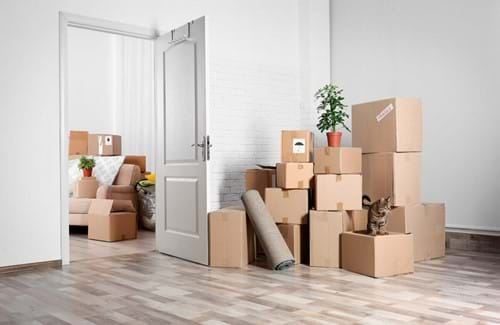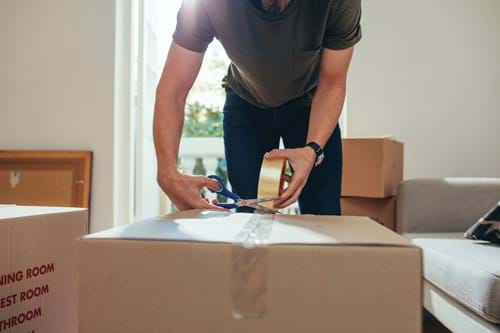Moving house is an exciting time full of promise, but it can also be one of the most stressful times.
Even if you’ve survived the countless conversations with estate agents, unexpected negotiations and endless chasers to solicitors, there’s still the task of physically moving your belongings. Packing up, moving and unpacking all your possessions at once is likely to cause a few grey hairs for even the calmest among us.
Here at phs Teacrate, we’ve built up a lot of expertise in this area over the years, so we’ve gathered the top house moving tips you may not have thought of to try and eliminate some of the stress and issues along the way.
This guide focuses on the actual process of moving and how to easily move your possessions without damage or extra work. If you’re looking for tips on getting prepped for the move itself, read phs Teacrate’s moving house checklist.
The tips below are all relatively simple to follow but we have seen what happens when movers use them, compared to what happens when they don’t; and we can guarantee every single one of these steps will save you time, effort, stress, and potentially money too.

Let’s take a look:
Prevent Things Escaping
You’ll no doubt have more than several small items that are moving with you (think cutlery, stationery, make up etc). This takes care of itself if you’re hiring removal crates, as all items will be packaged nice and securely with a closed lid. However, if you’re doing it the old-fashioned way, you may be tempted to simply throw them in boxes and hope for the best.
However, this is not a good idea as it will lead to items bouncing around in transit risking getting damaged and potentially even flying out of the box entirely. This is without even mentioning the potential damage to other items (I don’t fancy the chances of a flat screen TV against a box of flying cutlery).
Instead, package your small items together to ensure the contents remain secure for the entire journey. Traditionally, movers have done this with clingfilm as it binds items together securely and is both flexible and versatile. However, to keep your plastic use down, wrap your items in bundles with paper or string or any elastic bands you may already have stored up in your drawers. This method will give you increased security for your items and peace of mind while moving.
Cool boxes for food preservation
If your freezer and refrigerator are well stocked, the last thing you want to do is throw away food, causing expensive wastage.
It’s extremely common to find movers running down their inventory of frozen food over the weeks before the move, so that they can turn off their freezer without issue. There’s nothing wrong with this if it’s easily done, but if it’s weeks of effort or you just can’t face another night of frozen drumsticks and peas from the back of the freezer, there is a much better way.
If you’ve ever been camping, you’re likely to own a cool box. By putting all your frozen food in there with cool packs or even chunks of ice straight from the freezer, you can keep frozen food fresh for up to 48 hours. And some more powerful cool boxes will keep it fresh for more than two days, allowing you to move your food easily to your new home just like any other possession. Even if you don’t own a cool box, you may find that this investment is still more economical than wasting significant amounts of food.
To help at the other end of the move, ensure that the sellers have left the refrigerator powered on when they leave if you’re inheriting one with the property or, if you’re moving your own, pack it last and ask your movers to get it in place and switched on as one of their first jobs.
Use Soft Items as Protection
Think of everything soft you own – from clothing and towels to pillows and bedding. Since all this is coming with you anyway, why not wrap it around the more fragile items such as plates, glasses, the TV and other electrical equipment? This saves space, negates the need to buy additional protection for these items and reduces the chance of damage all at the same time.
You can also get creative with using leftover items from your home as protection, such as putting paper plates between your real plates to prevent them scratching against each other, filling sandwich bags with air to make makeshift packaging bubbles or using clean dusters and cloths as cushioning.
The golden rule is to ensure things are packed tightly enough that they don’t clatter or move around when the container is moved, as this means they’re less likely to collide with each other and cause damage during transit.

Use All Your Empty Space
When it comes to emptying your kitchen, you may find you have a large number of spices, sauces and other small jars and bottles. Instead of putting them loose in a box, consider packing them tightly into small spaces that are available, such as in saucepans with the lid closed or inside blenders and other appliances. It’s the equivalent of stuffing socks into your shoes when packing your suitcase to go on holiday. This way they’ll be protected from damage, unlikely to leak all over your other items, and take up close to zero space.
Don’t Use Cardboard Boxes for Books
It can be tempting to empty your bookcase into cardboard boxes, particularly as they fit so perfectly into the space. However, it’s easy to underestimate how heavy these will be. Not only is a full-size cardboard box full of books difficult to carry, but it’s very likely the bottom will cave in at some point despite how much tape you wrap round it.
One option is to split your book collection up, only putting a few books into each cardboard box. This can reduce the weight in each box and make cardboard viable, although it can be more of a task when it comes to unpacking and putting the collection back together at the other end.
Plastic crate hire is a great way to get around this issue as these heavy-duty crates can handle a lot more weight. Not only are they robust and secure, but they are also stackable and easier to transport. Plus, you can simply return them afterwards to be cleaned and used again saving you from having to dispose of so much cardboard.
Make Cardboard Boxes More Comfortable to Hold
Another benefit of plastic moving boxes is that they come with ergonomic designs and built-in handles, making them very easy to carry.
Cardboard boxes on the other hand often have no such option, forcing you to hold the box from the bottom. With smaller boxes this may be fine, but with heavy ones it’s very difficult and can make it easier to drop them. If you do use cardboard, a good way around this is to take a Stanley knife and cut handles into the side of the box, allowing you to lift it from a more comfortable angle.
Don’t Use Newspaper
It is extremely common for movers to use newspapers to wrap items when packing. This may seem like a good idea, especially if you have lots hanging around. However, there are two reasons why this may not be your best option. Firstly, newspaper rips very easily meaning it’s not very protective unless you use huge amounts. Secondly, newspaper print can very easily transfer which can damage and mark your items. At the very least, magazine paper is glossy so it’s strong and the ink is less likely to run which will make a difference. Alternatively, buy or hire packaging materials which will be well worth the investment.
Get the Right Materials
Trawling supermarkets is one way of collecting boxes for packing. But do you really have the time, and can you stand that many trips? Instead, get all the boxes you need in prime condition by ordering them in from phs Teacrate. This can range from quality cardboard boxes to returnable plastic crates alongside all your packaging materials. In addition to tape, labels, packing paper and bubble wrap, you can find transit blankets, tissue paper and protective bags for specific items such as mattresses, chairs, TVs and computers.

Label, label, label
When you’re packing you may think that you’ll remember roughly what you packed in each box. But after the move when you reach the other side, it will all be a distant memory. Labelling is the solution. Either write on each box exactly what’s inside, highlighting if there’s a key item you know you’ll end up looking for. Or if you’re super organised, number each box and write a separate list detailing its contents, with different boxes for each room.
Get help if you need it
If the stress of moving house and keeping all your possessions safe and undamaged is a little bit too much to handle, we can take care of this for you.
phs Teacrate is the UK’s leading supplier of moving crate hire, packaging, and other home removal services. We also offer specialist commercial moving services such as for the automotive industry, Covid-safe moving of pharmaceutical items, school moving services and more.
To learn more about phs Teacrate, our products and services, contact us now and see how we can help you move easily and securely.

